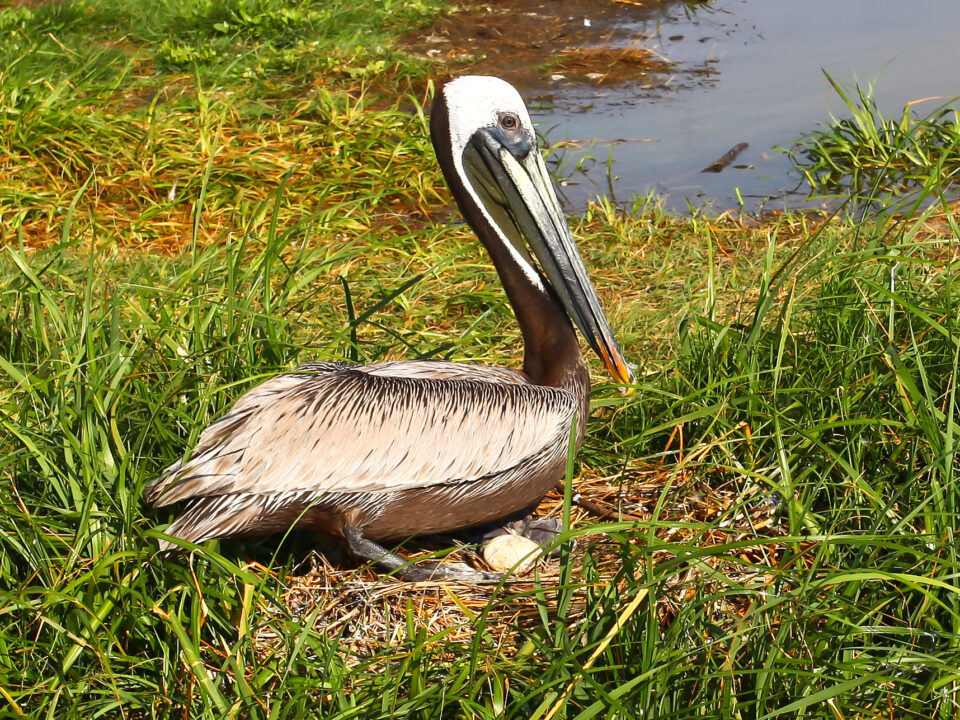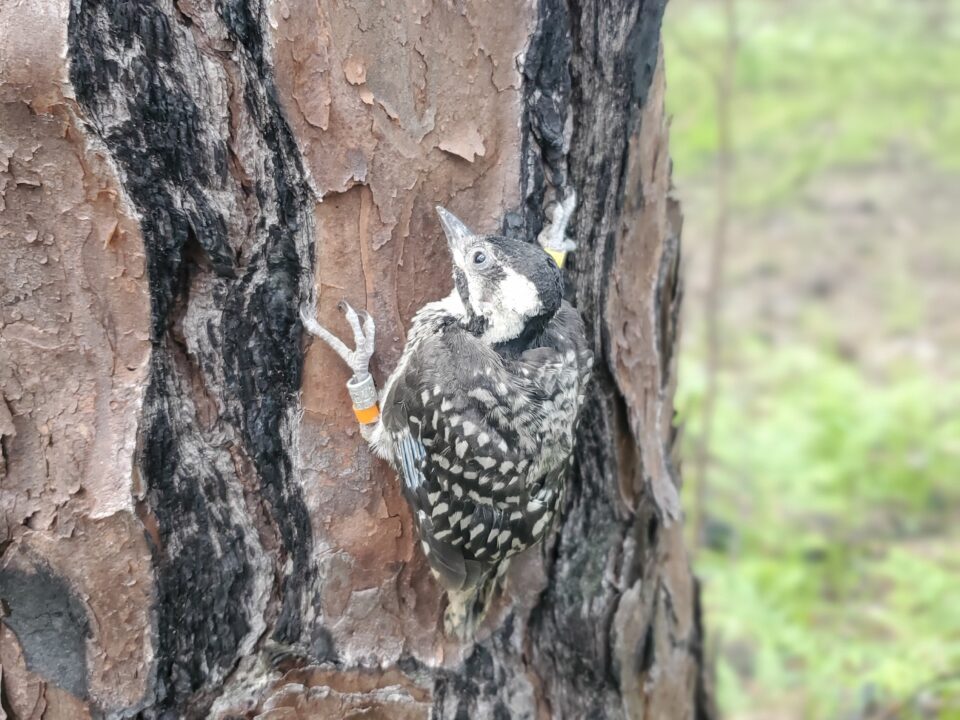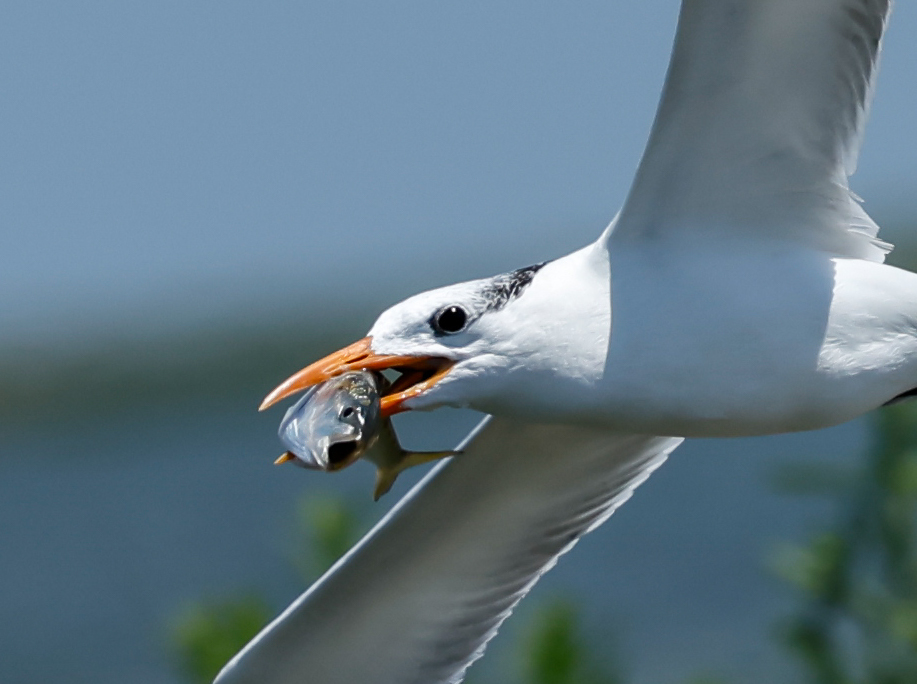Big Mud
Eagle photographers contribute to science
April 4, 2017
Another Raptor Kill in Argentina
April 6, 2017One day after our arrival in Panama City, we stood on the shoreline looking in awe over the mudflats that stretch out into the blue haze of the Pacific. As the tide reached its low, the flats extended more than a mile out to the horizon and more than thirty miles down the coast toward Columbia. We had all worked birds on mudflats. It was not just the scale of the flats here that was so imposing but the fact that if you stepped off the hard shoreline you could immediately be up to your waist in mud that had the consistently of chocolate pudding. Standing on the edge conjured up childhood images of the Le Brea Tar Pits trapping saber-toothed cats and short-faced bears to their deaths. But even on that first day we knew that we would have to venture out onto those flats.

Lost doll washed up on the mudflats along the shoreline near Panama City. Photo by Bryan Watts.
The mudflats here are enriched by both sea and land. They are bounded on the ocean side by the edge of the shelf that drops off quickly into the deep. Onshore winds during the winter months create upwellings that bring nutrients from the ocean depth up to the flats. Rains and tides wash nutrients from the land onto the flats. Twice a day the tides reach back to the shanties and pull out the leavings of the city. The debris flows out in a plume that is pushed toward land by the wind and long-shore current, ultimately piling high along the shoreline. The great garbage dune is a mirror of life in the city. Anything that floats ends life here unless given a reprieve by shoreline pickers; thousands of dolls lost by school girls, old knick-knacks and discarded figurines, car parts and valuable wood, but mostly plastic drinking bottles. With the debris is the raw sewage from one million people that flows out into the Bay and mixes with the mud. There are also tons of leaves from the fringing mangroves that are washed by the tides out onto the flats. All of these inputs are part of a complex food web that supports the birds that congregate here.
Over the next three months we worked throughout the upper Bay with scores of waterbird species. We conducted weekly aerial surveys, surveyed miles of transects through non-tidal habitats, and captured, measured, and marked more than 1,000 shorebirds. We sat along the shoreline and observed how birds used the mudflats. We recorded the time it took for birds to move out over the flats on a falling tide and how an incoming tide pushed and crowded birds together, causing species with different tactics to abandon foraging and go to roost at different times. We quantified foraging and movement rates and categorized foraging modes. We were collecting information that would be used by the United States Department of Defense and State Department to make recommendations to the Panamanian government about the significance of the Panama Canal and surrounding waterways to waterbirds. The year was 1997 and recommendations were being prepared in advance of the historic transfer of the canal and surrounding lands from the U.S. to Panama.
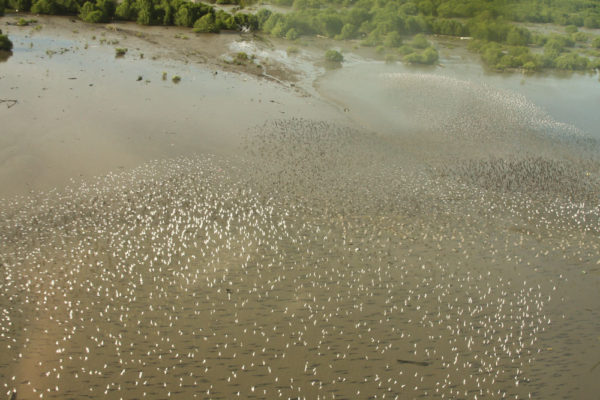
A flock of shorebirds takeoff in response to the survey plane. Surveys within the upper Bay are intense with flocks that may stretch out for kilometers. Photo by Bart Paxton.
After three months of working day and night, we had documented many important dimensions of the waterbird community and we had reinforced what we knew the first day. The spectacle of waterbirds that congregate here all come to exploit an enormous concentration of energy. Here, the mudflats are the provider, the giver of life. If you want to understand the waterbird community you must confront and address the mudflats directly. What is hidden in the mud that is so valuable to birds? Why are some species of shorebirds confined to the edge and never venture out onto the flats? Why do the mudflat species not move out with the tide line as in most tidal systems?
In early November, we set the date for our mudflat adventure. As the day approached we all went to the market on Avenida Central to buy high-topped tennis shoes in the hope that they would outlast the mud. Our plan was to follow the tide out and collect sets of benthic cores every fifty meters out to three hundred meters. We would place the samples in coded zip-lock bags and pull them in crates across the mud on flat boards like sleds. We would move out with the tide because we knew that we had a limited window and did not want to be caught out in the mud as the eighteen-foot tide roared back in to shore.
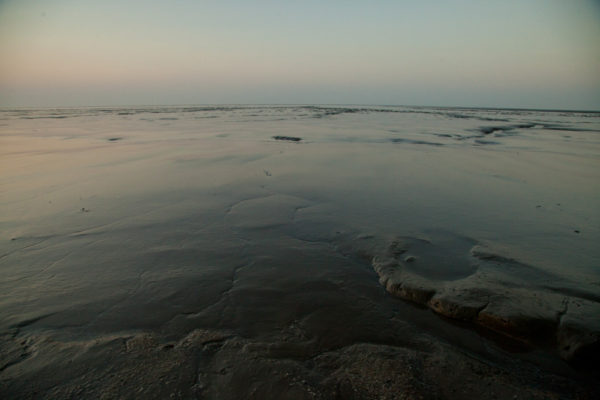
Mudflats exposed at dawn with the falling tide. The silky sheen on the surface of the flats is present just as the tide recedes. Photo by Bryan Watts.
We arrived before high tide in shorts and high tops and began to prepare the field gear. Alberto Castillo, our local technician, emerged from his truck dressed in yellow rain pants duct tapped around the ankles. After our visit to the shoe store he had returned to the market with a plan. Alberto had been sheepish about venturing into the mud from the first time it was mentioned. He had lived his entire life here along the Bay but had never been on the flats. He said that he did not want to get the mud on his skin. As we prepared the gear he seemed thrilled with the improvised solution to his dilemma.
We stood ready along the shoreline in teams of two as the tide turned. Its retreat is like a metronome, slow and steady. We followed. Alberto was with me and within thirty meters his well-crafted plan began to fall apart. The intense suction of the mud shredded and stripped the rain pants leaving him to get the full experience of the mud in his undies for the next two hours. There are few things that focus the mind and free the soul like being all in on a new adventure. We collected the fifty-meter samples and when we reached the one hundred-meter sampling station we paused to let the tide move out ahead.
A mix of shorebirds, including mostly western and semipalmated sandpipers, feed in a tiny section of mudflat as the tide falls. Video by Bart Paxton.
Over the next ten minutes, we would begin to understand some of the patterns we had observed sitting along the shoreline. The mud surface around us was covered with a silky sheen. We had observed the sheen for weeks and knew that the birds shunned it. What we could not tell was that the silky texture was just the surface of a wet, soupy layer that was several inches thick. Birds could not stand in this layer. As the tide continued to recede, this layer would collapse down to the more firm surface of the mud and lose the silky sheen. As this happened, shorebirds appeared in waves all around us. They moved across the surface and foraged within feet of us as if we were lifeless dolls stranded in the mud.
Being embedded within the mud with shorebirds probing around our field gear was like being set down in a different world. We were only meters from the shoreline where we had sat for weeks looking out but the experience was wholly different. The odd contrast of the world class mudflats juxtaposed with the skyscrapers of Panama City was not just visual. The bustling city with all of its traffic jams, shopping areas, restaurants, and nightlife was a world away. We could just as easily have been standing in the middle of the Sahara. Here, birds and people exist in different dimensions. Standing out on the flats was like being given the opportunity to gaze through a window from the other side.
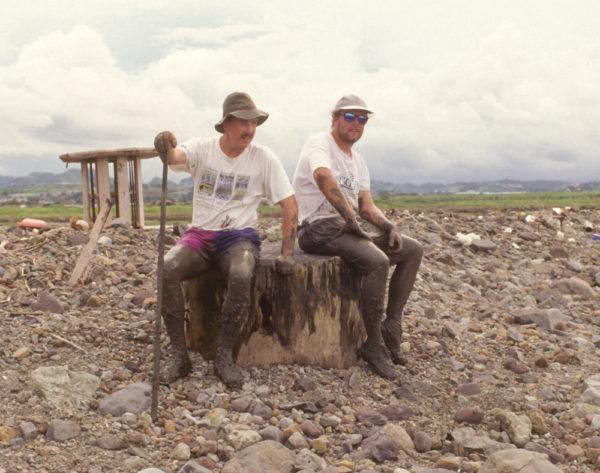
Dana Bradshaw (left) and Bart Paxton rest after surviving an adventure out onto the mudflats to collect benthic samples. Photo by Bryan Watts.
We have returned to the Upper Bay of Panama several times over the years to study waterbirds and Panama Audubon now has a program focused on the conservation of shorebirds using the flats. There are many things that can be learned while sitting along the shoreline. But there is something about seeing the world through the eyes of another species if only for a passing moment that goes a long way toward framing the questions worth pursuing.
Additional Photos:
[easy_image_gallery]
Written by Bryan Watts | bdwatt@wm.edu | (757) 221-2247
April 5, 2017


